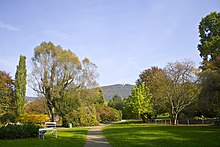
The Philipps University of Marburg is a public research university located in Marburg, Germany. It was founded in 1527 by Philip I, Landgrave of Hesse, which makes it one of Germany's oldest universities and the oldest still operating Protestant university in the world. It is now a public university of the state of Hesse, without religious affiliation.

An alpine garden is a domestic or botanical garden, or more often a part of a larger garden, specializing in the collection and cultivation of alpine plants growing naturally at high altitudes around the world, such as in the Caucasus, Pyrenees, Rocky Mountains, Alps, Himalayas and Andes. It is one of the most common types of rock garden.

The Old Botanical Garden is a botanical garden and arboretum in the Swiss city of Zürich. The garden is, among the neighbored Schanzengraben moat and the Bauschänzli bastion, one of the last remains of the Baroque fortifications of Zürich, that was begun in 1642.

The Botanischer Garten der Universität Würzburg is a botanical garden maintained by the University of Würzburg. It is located at Julius-von-Sachs-Platz 4, Würzburg, Bavaria, Germany, and open daily; admission is free.

The Forstbotanischer Garten und Pflanzengeographisches Arboretum der Universität Göttingen, often called the Forstbotanischer Garten und Arboretum, is a 40 hectares arboretum and botanical garden maintained by the University of Göttingen. It is located at Büsgenweg 2, Göttingen, Lower Saxony, Germany, immediately adjacent to the New Botanical Garden, and open to the public daily.

The Old Botanical Garden of Göttingen University, with an area of 4.5 hectares, is an historic botanical garden maintained by the University of Göttingen. It is located in the Altstadt at Untere Karspüle 1, adjacent to the city wall, Göttingen, Lower Saxony, Germany, and open daily.

The Botanischer Garten der Johannes Gutenberg-Universität Mainz, also known as the Botanischer Garten Mainz, is an arboretum and botanical garden maintained by the University of Mainz. It is located on the university campus at Franz von Bentzel-Weg 9, Mainz, Rhineland-Palatinate, Germany, and open daily.

The Botanical Garden of TU Darmstadt is a botanical garden maintained by the Technische Universität Darmstadt.

The Old Botanical Garden in Kiel, also known as the Old Botanical Garden on the Fjord, is a former botanical garden and arboretum located at Düsternbrooker Weg 19, Kiel, Schleswig-Holstein, Germany. It is open daily without charge.
The Botanischer Garten Aachen is a botanical garden maintained by RWTH Aachen. It is variously known as the Botanische Garten der RWTH Aachen, more formally the Botanische Garten der Rheinisch-Westfälische Technische Hochschule Aachen, and sometimes the Freundeskreis Botanischer Garten or Biologischen Zentrums Aachen BIOZAC für Ökologie und Umweltpädagogik. It was originally located at Melatener Straße 30, Aachen, North Rhine-Westphalia, Germany, with a new addition located on Rabentalweg. Both are open daily without charge.

Greifswald Botanical Garden and Arboretum, was founded in 1763. It is one of the oldest botanical gardens in Germany, and one of the oldest scientific gardens in the world. It is associated with the University of Greifswald in Greifswald, Germany.

The Botanischer Garten Münster is a botanical garden maintained by the University of Münster.

The Botanischer Garten der Christian-Albrechts-Universität zu Kiel, or less formally the Botanischer Garten Kiel, is a botanical garden and arboretum maintained by the University of Kiel. It is located at Am Botanischen Garten 1, Kiel, Schleswig-Holstein, Germany, and open daily.

The Botanischer Garten Frankfurt am Main is a botanical garden and arboretum formerly maintained by the Goethe University and since 2012 administered by the City of Frankfurt. It is located at Siesmayerstraße 72, Frankfurt am Main, Germany, and opens daily in the warmer months.

The Botanische Gärten der Friedrich-Wilhelms-Universität Bonn, also known as the Botanischer Garten Bonn, is a botanical garden and arboretum maintained by the University of Bonn. It is located at Meckenheimer Allee 171, Bonn, North Rhine-Westphalia, Germany, and open except Saturdays in the warmer months; admission is free.
The Neuer Botanischer Garten der Universität Göttingen, also known as the Experimenteller Botanischer Garten, is a research botanical garden maintained by the University of Göttingen. It is located immediately adjacent to the university's Forstbotanischer Garten und Arboretum at Grisebachstraße 1, Göttingen, Lower Saxony, Germany, and open daily without charge.

The Botanischer Garten Marburg, also known as the Neuer Botanischer Garten Marburg, is a botanical garden maintained by the University of Marburg, located on Karl-von-Frisch-Straße, Marburg, Hesse, Germany, and open daily. An admission fee is charged.

The Botanischer Garten der Universität Tübingen, also known as the Botanischer Garten Tübingen or the Neuer Botanischer Garten Tübingen, is a botanical garden and arboretum maintained by the University of Tübingen. It is located at Hartmeyerstrasse 123, Tübingen, Baden-Württemberg, Germany, and open daily.

Julius Wilhelm Albert Wigand, known as Albert Wigand, was a German botanist, pharmacologist and pharmacognostician. His is most well known for being the director of the Alter Botanischer Garten Marburg from 1861 to 1886, and for his opposition to Charles Darwin and the theory of Evolution on religious grounds.

Georg Wilhelm Franz Wenderoth was a German pharmacist and botanist.


















